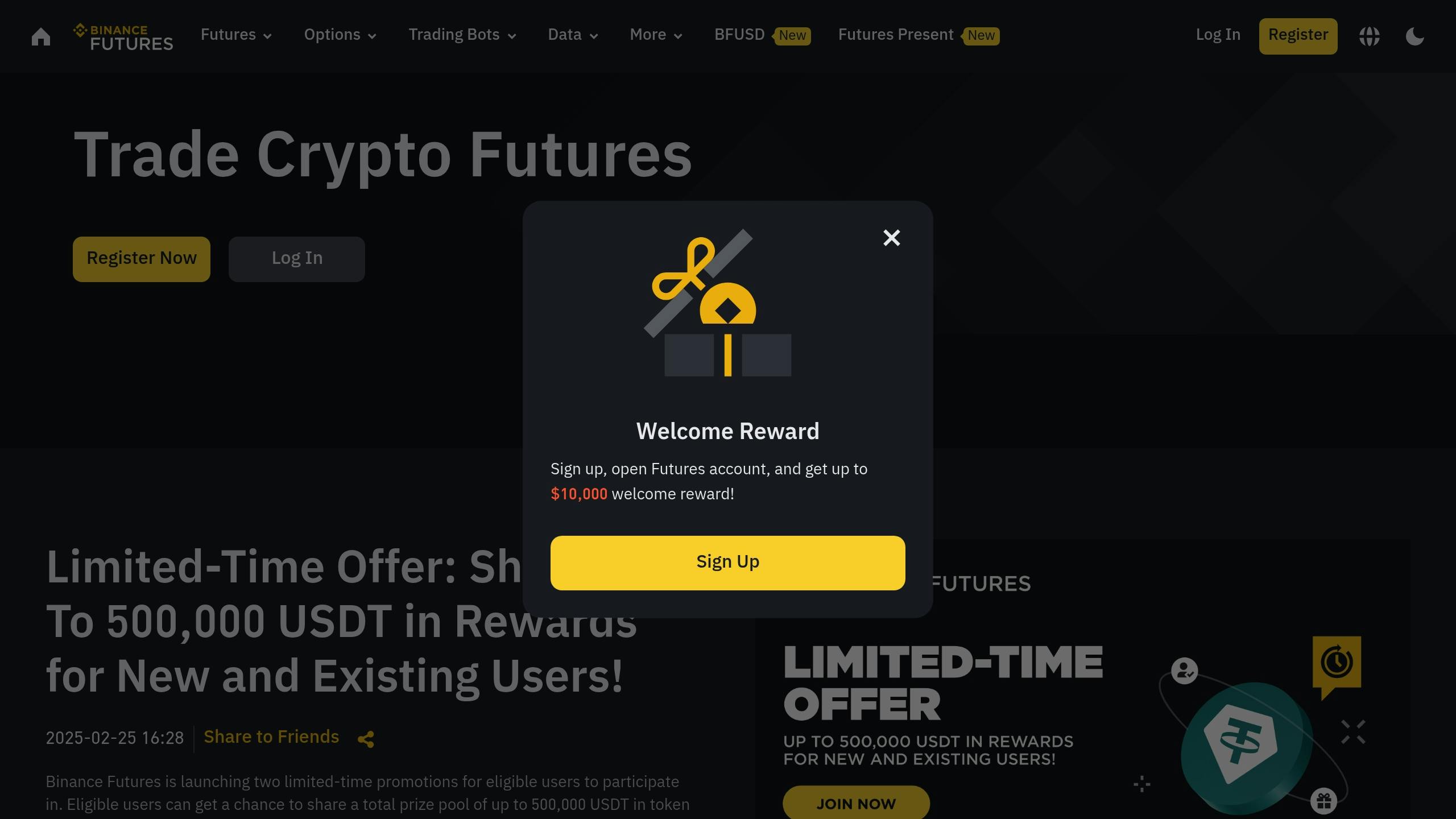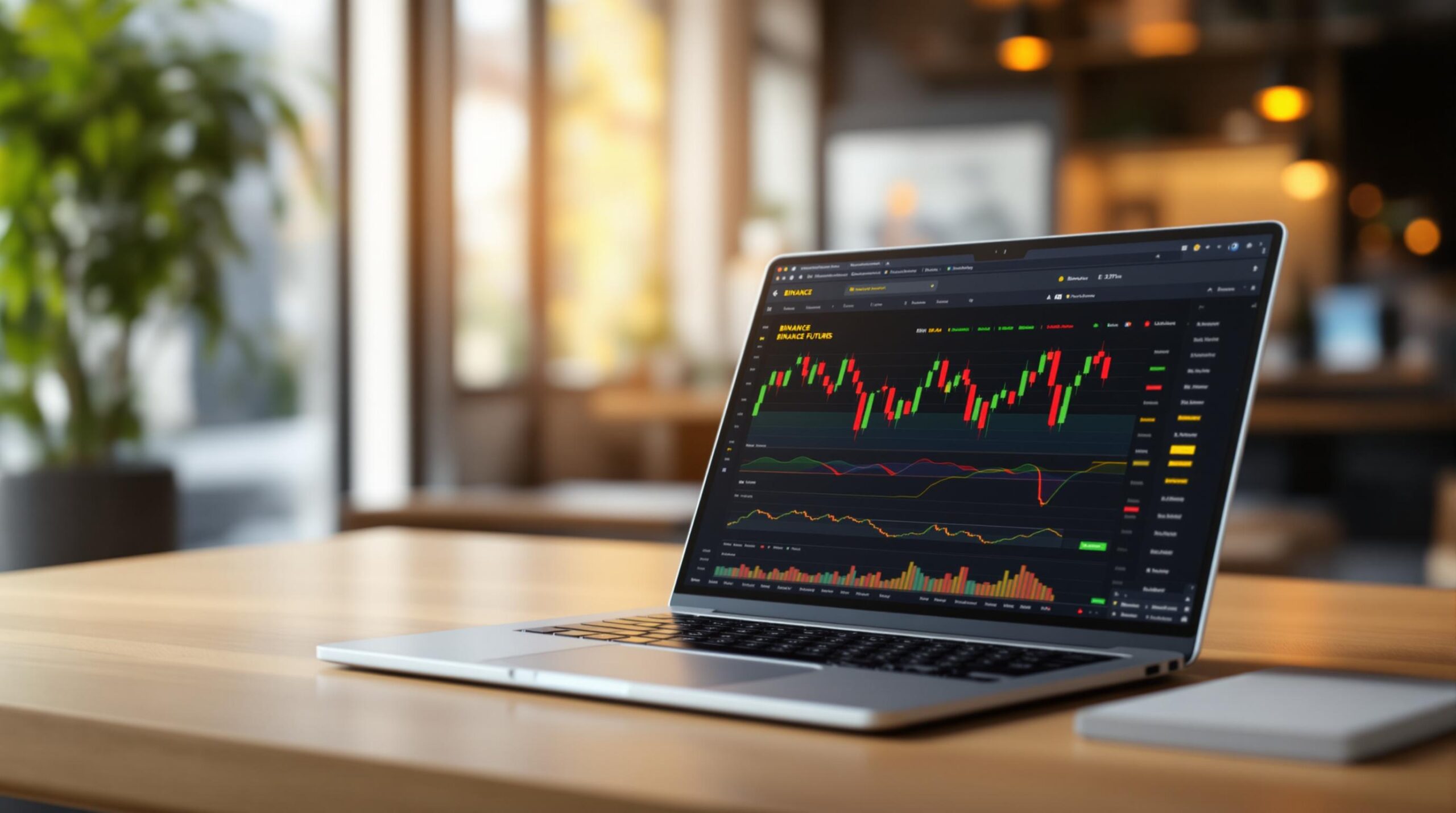Binance Futures is a cryptocurrency derivatives platform offering advanced trading tools, high leverage (up to 125x), and over 340 trading pairs. It supports two types of contracts: COIN-Margined (settled in cryptocurrency) and USD-Margined (settled in stablecoins like USDT). With competitive fees starting at 0.02% for makers and 0.05% for takers, it attracts traders worldwide – though U.S. users are restricted due to regulatory issues.
Key Features:
- Leverage: Up to 125x for BTC/ETH (default capped at 5x for new users).
- Trading Pairs: Over 496 pairs available.
- Fee Discounts: 10% off fees when using BNB for payments.
- Safety Tools: Price protection, stop-loss/take-profit orders, and a $1 billion SAFU fund for user protection.
- Platform Access: Web, mobile apps, and API for automated trading.
Quick Comparison Table:
| Feature | Binance Futures | U.S.-Regulated Platforms (e.g., Coinbase) |
|---|---|---|
| Leverage | Up to 125x | Up to 10x |
| Trading Pairs | 496+ | Limited |
| Fees | 0.02%-0.05% | Higher |
| Availability | Restricted in the U.S. | Available in the U.S. |
| Custody | Centralized | Centralized |
Binance Futures is ideal for experienced traders seeking high leverage and diverse trading options but requires careful risk management. Novice traders should start with lower leverage and explore Binance’s educational resources.
Binance Futures Trading Tutorial For Beginners

Platform Setup Guide
Ready to dive into Binance Futures? Here’s a step-by-step guide to get your account up and running.
Creating Your Account
Setting up a Binance Futures account is straightforward. Here’s how:
- Visit Binance’s website and click on "Sign Up".
- Complete the required identity verification process.
- Go to the "Futures" section and choose "Open Account".
- Carefully review the Service Agreement and pass the mandatory quiz.
Deposit Methods
Binance offers multiple ways to fund your account. Here’s a quick breakdown:
| Deposit Method | Fee | Minimum/Limits |
|---|---|---|
| Cryptocurrency | Free for most coins* | Varies depending on the network |
| Credit Card (VISA/MasterCard) | 2% per transaction | Weekly spending cap applies |
| SEPA (EUR) | €1 flat fee | No minimum |
| SEPA Open Banking | 0.12% | Depends on your region |
*Some cryptocurrencies, like Terra Classic and TerraUSD, include a 0.5% tax burn fee.
Platform Layout
The Binance Futures interface is designed to feel familiar if you’ve used their spot trading platform, but with added tools for trading derivatives:
- Main Trading Panel: A central chart display with integrated trading tools and execution options.
- Position Management: Easily monitor your open positions, profit/loss, leverage, and margin details.
- Order Types Panel: Access various order types, including market, limit, stop-loss, and take-profit options.
You can seamlessly transfer funds between the spot and futures platforms. Plus, Binance offers mobile trading apps for both Android and iOS devices, so you can trade on the go.
Once your account is set up, you’re ready to explore trading strategies on Binance Futures. Stay tuned for tips on maximizing your trades!
Trading Options
Once your account is set up, it’s time to dive into the trading mechanics that make Binance Futures stand out.
Market Pairs and Contracts
Binance Futures offers a staggering 496 trading pairs. The platform supports two main types of contracts:
- COIN-M Contracts: These are settled and collateralized in cryptocurrency, making them ideal for long-term holders.
- USD-M Contracts: Settled in stablecoins like USDT or USDC, these contracts simplify return calculations, especially for short-term trades.
With a daily trading volume of $95.89 billion, the platform’s market activity is undeniably robust. Before diving into trades, it’s crucial to understand how these contracts work, especially when paired with leverage.
Leverage Settings
Binance Futures allows traders to use leverage ranging from 10x to 125x. Here’s a breakdown of how leverage can amplify your trading positions:
| Initial Investment | Leverage | Position Size | Impact of a 1% Price Change |
|---|---|---|---|
| $1,000 | 10x | $10,000 | $100 (10%) |
| $1,000 | 50x | $50,000 | $500 (50%) |
| $1,000 | 125x | $125,000 | $1,250 (125%) |
"Higher leverage means higher risk, and it’s easy to lose more than you initially invested if the market doesn’t move in your favor".
Safety Features
High leverage comes with higher risks, so Binance Futures incorporates several safety measures to protect traders:
- Price Protection: Keeps an eye on the gap between the Last Price and the Mark Price to prevent extreme price movements.
- Default Leverage Limits: New accounts start with a 5x leverage limit, which is capped at 20x for the first 60 days.
- Advanced Take-Profit/Stop-Loss (TP/SL) Tools: These allow traders to set predefined profit or loss thresholds.
Additionally, Binance has created the Secure Asset Fund for Users (SAFU), a $1 billion reserve that includes $700 million in BNB and $300 million in BUSD. This fund is designed to protect users during volatile market conditions.
For those who need a break or want to avoid impulsive decisions, Binance offers a Cooling-off Period feature to temporarily disable futures trading. Moreover, its real-time monitoring system can detect suspicious activity, automatically suspending withdrawals for 24–48 hours to enhance security.
sbb-itb-dd9e24a
Costs and Rules
Fee Structure
Binance Futures uses a maker-taker fee model, where fees depend on your VIP level and trading volume. Regular users start with maker fees of 0.02% and taker fees of 0.05%. Below is a breakdown of fees for different contract types:
| Contract Type | Regular User Fees | VIP 9 Fees (Highest Tier) |
|---|---|---|
| USDT-M Futures | Maker: 0.02%, Taker: 0.05% | Maker: 0%, Taker: 0.017% |
| COIN-M Futures | Maker: 0.02%, Taker: 0.05% | Maker: 0%, Taker: 0.017% |
| USDC-M Futures | Maker: 0.018%, Taker: 0.045% | Maker: 0%, Taker: 0.0153% |
You can lower your fees by 10% if you use BNB to pay them. The platform also employs a funding rate system that adjusts perpetual contract prices every 8 hours to align with spot market prices.
Trading Boundaries
Binance has specific rules for leverage and position limits. Here are some key updates:
-
Leverage changes:
- BTC quarterly contracts: capped at 50x (down from 125x)
- ETH quarterly contracts: capped at 50x (down from 100x)
- USDT-margined perpetual contracts (e.g., CTKUSDT, SANDUSDT): capped at 50x
-
Order limits for trading pairs:
- BTC/USDT: Minimum order size of 0.00001 BTC, maximum limit of 9,000 BTC
- ETH/USDT: Minimum order size of 0.0001 ETH, maximum limit of 9,000 ETH
Regulatory developments also influence these trading parameters.
Legal Requirements
Binance has faced legal challenges in the U.S., including over $4.3 billion in penalties paid to various regulatory agencies. CFTC Chairman Rostin Behnam criticized Binance’s actions, stating:
"Binance’s activities undermined the foundation of safe and sound financial markets by intentionally avoiding basic, fundamental obligations that apply to exchanges, all the while collecting approximately $1.35 billion in trading fees from U.S. customers."
Binance Futures is not available to U.S. traders. While Binance.US operates as a separate platform for American users, it does not support futures trading. Binance holds money transmitter licenses in 32 U.S. states, but these licenses apply to spot trading rather than futures.
Platform Analysis
Strong Points
Binance Futures stands out as a top-tier cryptocurrency derivatives platform, offering several advantages to traders. Its matching engine can handle up to 100,000 orders per second with a lightning-fast 5-millisecond latency. This ensures trades are executed quickly, even during periods of high market activity.
Another major benefit is its liquidity depth. With monthly trading volumes surpassing $4.3 billion, the platform provides tight bid-ask spreads, averaging just 0.3% during intraday trading. For traders, this means better pricing and minimized slippage.
The platform also offers a wide range of trading tools to enhance the user experience:
| Feature Category | Capabilities |
|---|---|
| Technical Analysis | TradingView-powered charting, multiple timeframes |
| Order Types | Market, Limit, Stop-loss, Take-profit |
| Account Management | Sub-accounts with separate trading environments |
| API Integration | Support for automated trading strategies |
| Contract Options | USDT-M, Coin-M, and Perpetual Futures |
While the platform delivers strong performance and tools, certain regulatory and structural issues impact its overall appeal.
Weak Points
Binance Futures faces notable challenges related to regulatory compliance and market access. Recent enforcement actions have highlighted these issues. For instance, the CFTC’s complaint brought attention to significant compliance gaps. Gretchen Lowe, Principal Deputy Director of the CFTC’s Enforcement Division, stated:
"Defendants’ alleged willful evasion of U.S. law is at the core of the Commission’s complaint against Binance. The defendants’ own emails and chats reflect that Binance’s compliance efforts have been a sham and Binance deliberately chose – over and over – to place profits over following the law".
Additionally, Binance Futures has structural limitations when compared to decentralized platforms:
| Aspect | Binance Futures | Decentralized Platforms |
|---|---|---|
| Fund Custody | Centralized control | User-controlled private wallets |
| Regulatory Risk | High exposure | Lower regulatory dependency |
| Geographic Access | Restricted in many regions | Broad, generally unrestricted access |
| Transparency | Limited | Full on-chain visibility |
The centralized structure of Binance Futures also raises security concerns. Users must entrust Binance with custody of their funds, unlike decentralized exchanges (DEXs) where traders retain full control over their assets.
Summary
Main Points
Binance Futures stands out by combining advanced trading tools with a broad market presence. Here’s a quick breakdown of its strengths:
| Feature | Details | What It Offers |
|---|---|---|
| Trading Options | Up to 125x leverage on BTC/ETH | Greater profit potential |
| Market Coverage | 400+ cryptocurrencies, 1,200+ pairs | Wide variety of trading choices |
| Fee Structure | Starting at 0.02% maker / 0.05% taker | Cost-effective trading |
| Execution Speed | Industry-leading performance | Quick and reliable trades |
While Binance Futures provides advanced tools and deep market liquidity, it does face regulatory hurdles that can impact its accessibility and operations.
Recommendations
For traders at different levels, here’s how to approach Binance Futures effectively:
"Futures trading on Binance can be a powerful tool for making money, but it also carries significant risks. It is crucial that you educate yourself well and understand how futures work before investing."
- Advanced Traders: Take advantage of the platform’s detailed charting tools and a variety of futures contracts. Always enforce strict risk management strategies.
- Intermediate Traders: Begin with moderate leverage (10x-20x), use stop-loss orders consistently, and keep an eye on funding rates to manage positions effectively.
- Novice Traders: Focus on learning through the platform’s educational resources before diving in. Only trade with money you can afford to lose.
Your decision to use Binance Futures should align with your trading goals, risk tolerance, and any regional restrictions. Balancing the platform’s features against leverage risks and regulatory factors is essential.
